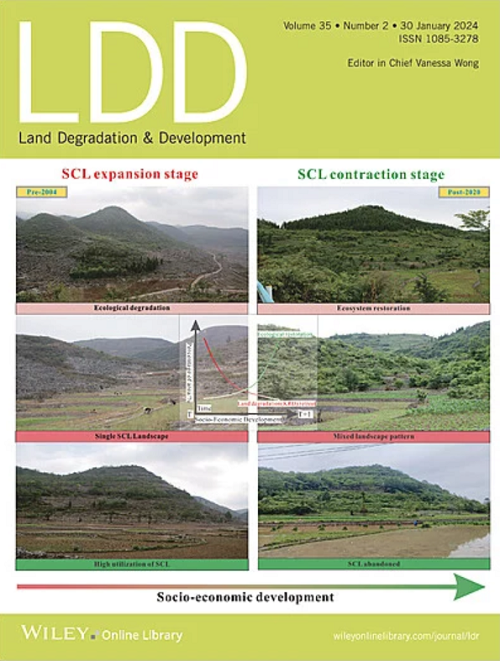多尺度生态系统服务可持续性的权衡/协同效应和驱动因素:来自华南喀斯特的见解
IF 3.7
2区 农林科学
Q2 ENVIRONMENTAL SCIENCES
引用次数: 0
摘要
生态系统服务(ES)与联合国可持续发展目标(SDG)的各个方面息息相关。了解生态系统服务可持续性的现状是实现生态系统优化管理的关键。然而,对跨尺度ESS的状态、关系和驱动机制的理解仍然有限。ESS的本质是ES的自然供给满足当前的社会需求而不影响以后的消费。因此,本文试图从生态系统供需角度分析华南喀斯特地区生态系统的多尺度及其驱动因素。从研究结果来看,生境质量(HQ)和碳固存(CS)的可持续性下降,而产水量(WY)、土壤保持(SC)和粮食供应(FP)的可持续性增强,且在流域尺度上变化幅度相对平缓。在县域尺度和流域尺度上,ESS的分布格局相似,但热点和冷点的空间聚类存在显著差异。ESS的权衡和协同效应随时间和空间尺度而迁移,国家以竞争的权衡为主导,流域以相互增强的协同效应为主导。社会和地形因素主要影响总部,而植被和社会因素主要驱动SC和CS。而WY受气候因素的控制更大,尤其是受降水影响最大。气候和地形因素是限制FP可持续性的主要因素。在这些中介效应中,有必要关注植被和社会因素的相互作用过程,积极的间接效应占主导地位。相反,气候与地形的相互作用过程往往具有较强的负间接效应,特别是在流域尺度上,需要加以防范。在未来的生态管理实践中,应加强多尺度管理,积极推进供需协同管理,化解多目标冲突,实现双赢。本文章由计算机程序翻译,如有差异,请以英文原文为准。
Trade‐Offs/Synergies and Drivers of Ecosystem Service Sustainability at Multiple Scales: Insights From the South China Karst
Ecosystem services (ES) are interconnected with various aspects of the United Nations Sustainable Development Goals (SDG). Understanding the status of ecosystem services sustainability (ESS) is crucial for achieving optimal ecosystem management. However, the understanding of the state, relationships, and driving mechanisms of ESS across scales remains limited. The essence of ESS is that the natural supply of ES meets current social demand without affecting later consumption. Therefore, we attempted to analyze the multi‐scale ESS and its drivers in the South China Karst region from the ES supply and demand perspective. From the results of the study, the sustainability of habitat quality (HQ) and carbon sequestration (CS) declined, while water yield (WY), soil conservation (SC), and food provision (FP) were enhanced, and the magnitude of change at the watershed scale was relatively gradual. The distribution patterns of ESS were similar at the county and watershed scales, but there were significant differences in the spatial clustering of hot and cold spots. The trade‐offs and synergies of ESS migrate with time and spatial scale, with counties dominated by competing trade‐offs and watersheds dominated by mutually reinforcing synergies. Social and terrain factors primarily influence HQ, while SC and CS are mainly driven by vegetation and social factors. Whereas WY is more controlled by climatic factors, especially most influenced by precipitation. Climate and terrain factors are the dominant factors limiting the sustainability of FP. Among the mediating effects, there is a need to focus on vegetation and social factor interaction processes, as positive indirect effects dominate them. On the contrary, the interactive processes of climate and terrain need to be guarded against, as they always have strong negative indirect effects, especially at the watershed scale. In the future practice of ecological management, we should strengthen multi‐scale management and actively promote synergistic management between supply and demand to resolve conflicts between multiple objectives and realize a win‐win situation.
求助全文
通过发布文献求助,成功后即可免费获取论文全文。
去求助
来源期刊

Land Degradation & Development
农林科学-环境科学
CiteScore
7.70
自引率
8.50%
发文量
379
审稿时长
5.5 months
期刊介绍:
Land Degradation & Development is an international journal which seeks to promote rational study of the recognition, monitoring, control and rehabilitation of degradation in terrestrial environments. The journal focuses on:
- what land degradation is;
- what causes land degradation;
- the impacts of land degradation
- the scale of land degradation;
- the history, current status or future trends of land degradation;
- avoidance, mitigation and control of land degradation;
- remedial actions to rehabilitate or restore degraded land;
- sustainable land management.
 求助内容:
求助内容: 应助结果提醒方式:
应助结果提醒方式:


